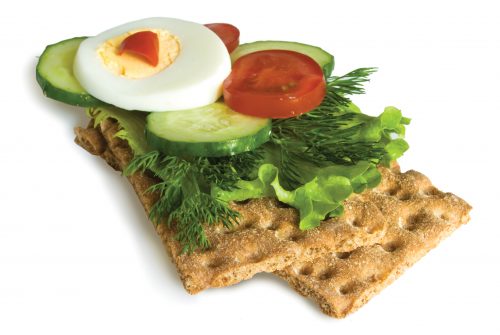
HFG senior nutritionist Rose Carr looks at healthier cracker options.
Crackers seem to enjoy a healthy image that is often undeserved. Some crackers have similar kilojoules, fat and salt to potato chips. If these are an occasional item on your plate, maybe that’s no big deal, but if you’re eating them often, now is a good time to review the options. It’s not what we do every now and again that makes the difference to our health — it is what we do on a regular basis.
Energy
We recommend looking for crackers with 1800kJ or less per 100g. The serving size varies, of course, but around 25g is a useful estimate, which means we are aiming for roughly 450kJ or less per serve. Huntley & Palmers Wholegrain Crackers (Spelt & Black Sesame) contain 1730kJ per 100g and a serve of four crackers at 27g has 470kJ. At the small cracker end of the spectrum the Signature Range Plain Rice Crackers have 1660kJ per 100g and a 25g serve with 415kJ is around 15 crackers.
Fat
The amount of fat in some crackers, and in particular saturated fat, can be shocking. In an ideal world, we recommend choosing crackers with 1g or less saturated fat, but 2g or less saturated fat is still pretty good. We found crackers with up to 13 per cent saturated fat, and we advise keeping well clear of those.
Fibre
Most of us need to take every opportunity to increase our fibre intake. The recently published Adult Nutrition Survey highlighted how low our average intakes are with women getting around 18g fibre each day and men around 23g. The adequate intakes are 25g and 30g for women and men respectively but the suggested dietary targets for better health are 28g and 38g. Big changes and small changes will all help increase the fibre in our diets.
When choosing crackers we recommend those with 5g or more fibre per 100g, but even better, choose crackers with 10g or more fibre per 100g. Unfortunately, not all packs state the fibre content. Whole grains and seeds add fibre which makes the crackers more satisfying as well as being better for heart and digestive health.
Sodium
Around 85 per cent of the salt (sodium chloride) in our diets is from processed foods. It’s easy to get a lot more sodium than is good for us, and most of us do, so it’s important to check labels and choose lower-sodium options when we can. This becomes even more important for people with high blood pressure.
Ideally aim for products with 500mg or less sodium per 100g, however, 800mg or less per 100g is still not too bad, depending on how many crackers we are eating. We saw crackers as high as 1200mg sodium per 100g and we advise giving those a wide berth.
Did you know?
- ‘Baked not fried’ does not necessarily equate to lower in fat – it just sounds as though it should.
- Mini versions of crackers do not usually have the same nutrition as the original, even if the packaging looks the same.
www.healthyfood.com










